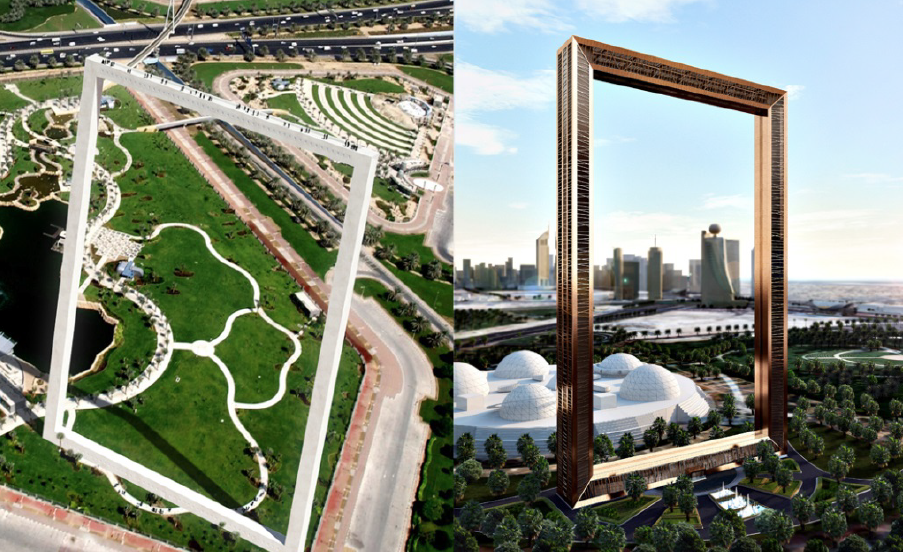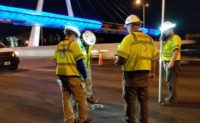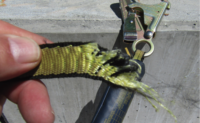The picture painted by Mexican-born architect Fernando Donis isn't a pretty one. And the defendants from Dubai so far haven't commented.
But Donis claims in a lawsuit filed late last year that Dubai has effectively stolen his design for the nearly complete Dubai Frame, an unusual, rectangular landmark structure, by violating his copyright and never completing a final contract for his services or design.
The lawsuit, filed in December in U.S. District Court for the District of Columbia, has been the subject of stories in the New York Times and other media outlets. Architectural copyright on international projects has been disputed before and is difficult to enforce. The allegations by Donis are unusual in that they involve a project for which the architect was paid a contest prize and had been negotiating with the defendants over copyright-related issues. A contract was never completed.
Donis, who has offices in Mexico City and Rotterdam, won a $100,000 prize competition in 2009 that sought designs for an “emblematic structure for Za’abeel Park in the center of Dubai” as the new face of the booming city in the United Arab Emirates.
But Donis contends that he then found himself “strung … along” for years by Dubai officials in the belief he would be able to develop the project himself, only to see the city break ground on his “Dubai Frame” without his permission, notes the lawsuit. Donis claims copyright infringement and is seeking relief.
Dubai went ahead and has almost completed construction of the $43 million, 492-foot-high picture frame without the architect’s permission or without signing any contract with him, according to the lawsuit, which argues that Donis never agreed to allow his designs to be used.
Numerous Defendants Named
Donis’ lawsuit names as defendants The Dubai Municipality, the United Arab Emirates Ministry of Foreign Affairs & International Cooperation, Al Bateen, King Abdullah Bin Abulaziz Al Saud Street, Abu Dhabi and the United Arab Emirates.
Efforts to contact the defendants were unsuccessful.
ThyssenKrupp AG, the elevator manufacturer, also is named as a defendant. In a statement, the company says the claim by Donis "has no basis at all" since Thyssenkrupp is not responsible for the project's construction and served only as the elevator supplier."
"While ThyssenKrupp conducted the architecture competition," the company states, it "had no role in the decision awarding the architedture contract" or "retaining an architect for the project."
So far, none of the other defendants has filed a reply to Donis' court complaint.
The frame, which is designed to highlight Dubai’s modern skyline, features two 492-foot-high towers, or “legs,” linked by a 141-foot bridge. Tourists and other visitors will be able to take in the city views as they ride up the towers in elevators and then walk across the bridge at top.
| The lawsuit claims that the infringing structure copied the specific expressive elements embodied in Donis’s design, including the proportions, height, building materials, directional orientation and allocation of spaces. |
“The Dubai Municipality simply went ahead and built his design without him, using architectural plans copied directly from the technical drawings that Donis submitted to the Competition,” the lawsuit contends.
Donis has also accused ThyssenKrupp Elevator, which ran the 2009 architectural contest and provided the elevators for the towers, of “profiting handsomely from the entire venture—all the while knowing it had infringed Mr. Donis’s rights.”
The Dubai Frame is expected to draw as many as two million visitors a year and generate millions in revenue, the lawsuit notes.
Donis and his legal team also lay out all the similarities between his design and the soon to open Dubai Frame to argue that the wealthy Gulf city didn’t just take his concept, but created an exact “replica.”
At 492 feet, the height of the Dubai project is exactly the same as Donis’ proposed Dubai Frame, while the dimensions and proportions are “substantially the same.” The concrete building materials and structural steel bridge – complete with triangular steel trusses - also matches Donis’ design, as does the “locations of elevators, stairs, and mechanical structures,” the lawsuit contends.
In addition,the Dubai project, like Donis’ Dubai Frame, has cultural and program space at the bottom and dining and sightseeing at the top.
And like Donis envisioned, the Dubai Frame is “located in Za’abeel Park and symbolically oriented to face both “Old Dubai” and “New Dubai,” providing views of both from the bridge observatory,” according to the lawsuit.
The Dubai government used slip-formed concrete, with the bridge lifted atop the finished towers, a process Donis claims to have suggested.
“The infringing structure did not just copy the idea of building a frame in Dubai,” the lawsuit notes. “It copied the specific expressive elements embodied in Mr. Donis’s design, including the proportions, height, building materials, directional orientation, and allocation of spaces within the structure.”
Competition Rules Cited
The lawsuit contends the competition rules were clear: all contestants “would maintain all copyrights in their works” and that Dubai officials would not be able to use the design until a contract had been signed. Moreover, the rules prohibited the use of any “preliminary design” without the agreement of the architect.
Things started off well, with Donis hiring an industrial designer from the Netherlands to a model of the Dubai Frame, which he presented to the Dubai crown prince at the award ceremony in May, 2009. Donis had beat out over 900 other competitors from across the world.
But Donis initial victory turned sour after years of inconclusive haggling over a contract. Dubai officials insisting that he could not work on his own in the city, but, under local rules, would have to have the help of local consultants.
Donis repeatedly attempted to include language in the contract that would protect his copyright and ensure his involvement in all stages of the project, but these were rejected by Dubai officials, the lawsuit contends. Donis refused to sign and Dubai officials, ignoring his warnings that they were violating his intellectual property rights, went ahead with construction and broke ground in 2014, with the project expected to open soon.





